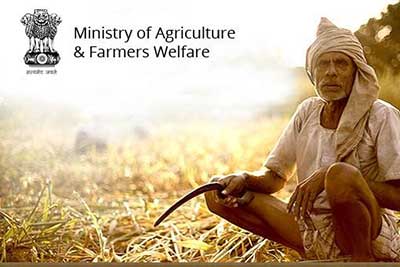Relevance: GS-3: Agricultural produce and issues and related constraints
Key Phrases: Ministry of Agriculture and Farmers’ Welfare, Green Revolution scheme, Pradhan Mantri Krishi Sinchai Yojana,Rashtriya Krishi Vikas Yojana,Krishionnati Yojana, National Beekeeping Honey Mission (NBHM), Farmer Producer Organizations (FPOs)
Why in News?
- The agricultural experts are not very satisfied with budgetary allocation to agriculture and allied sectors.
- The total allocation for the Ministry of Agriculture and Farmers’ Welfare for 2022-23 is ₹1.32 lakh crore , 0.7 per cent higher than the Budget estimates of 2020-21 and 4.3 per cent higher than the revised estimates (RE) of 2021-22.
- However, in real terms, there is no increase in the Budget for agriculture.
Key Highlights:
- The vision of the Budget 2022-23 has been limited regarding the agricultural sector, for both the sectoral focus as well as for the allocations.
- There is one notable change related to the semantics:
- The flagship Green Revolution scheme (which included more than 15 missions and schemes) and the Pradhan Mantri Krishi Sinchai Yojana (PMKSY) are restructured and are replaced by two schemes — Rashtriya Krishi Vikas Yojana (renewed) and the Krishionnati Yojana.
- The renewed RKVY now comprises the erstwhile Pradhan Mantri Krishi Sinchai Yojna, Paramparagat Krishi Vikas Yojna, National Project on Soil and Health Fertility, Rainfed Area Development and Climate Change, and Sub-Mission on Agriculture Mechanization including Management of Crop Residue.
- The Krishionnati Yojana comprises a few components of the erstwhile green revolution programme.
Editor's view: Budget gives needed preference to the allied sectors
- Unlike the department of agriculture, the allied sectors have
witnessed an increase in their allocations.
- The allocation for the Fisheries sector (₹2,118 crores) is increased by 73 percent.
- Animal Husbandry and Dairying (₹3,919 crore), up 26 per cent, compared to 2021-22.
- These steps would be a nitro-boost to push diversification of the agricultural economy.
- The Oilseed production is given a significant emphasis:
- An aim to reduce dependency of oil import, which currently accounts for 52 per cent of consumption.
- The government has allocated a total of ₹1,500 crore for both edible oil and palm oil programmes under the new Krishionnati Yojana.
- Three-fifth of this ₹1,500 crore are towards palm oil which may lead to considerable reduction in imports.
- Beekeeping is promoted in the Budget through a new central sector scheme titled; “National Beekeeping Honey Mission (NBHM)” with an allocation of ₹100 crore.
Criticism of Budget regarding R&D, FPOs, Natural Farming:
Stagnation in Agriculture research and development expenditure: The expenditure on agriculture R&D in India has been hovering around 0.3 to 0.4 per cent since 2001, except in 2011 when it reached 0.52 percent because of higher Plan allocations of the Union government.
- Expenditure on agricultural research has been kept unchanged implying a decline in real terms. Despite the fact that several studies have shown impressive rates of return on investments in agricultural research & development—both globally and in India.
- The amount spent on agriculture R&D is drastically low in
comparison to many developed countries and also with comparable developing
countries. As given below:
Countries Agriculture research expenditure with respect to agriculture GDP Brazil 1.8 per cent Mexico 1.05 per cent Malaysia 0.99 per cent China 0.62 per cent High-income countries 3.01 per cent. - Persistent under-investment in agricultural research and development does not augur well for the sustainable and inclusive agricultural growth that India aims to achieve.
- Push for Farmer Producer Organizations (FPOs) seems to be waning:
- In the last year’s Budget, the allocation for FPOs was increased by 40 per cent — from ₹500 crore in 2020-21 to ₹700 crore ($96 million) in 2021-22. For 2022-23, it stands at ₹500 crore — the same level as that of two years ago.
- It is disappointing to see this trend. Instead of consolidating the functioning and governance of FPOs, the government seems to have given up the emphasis on these emerging institutional innovations.
- Too much focus on the promotion of chemical-free farming:
- The initial phase will be implemented in the 5-km wide corridor along the river Ganga.
- States will be encouraged to revise syllabi of agricultural universities to meet the needs of natural, zero-budget and organic farming.
- This over-emphasis on chemical-free and zero-budget agriculture can pose a challenge to ensure long-term food and nutrition security of the country.
- The National Academy of Agricultural Sciences (NAAS) in its report on zero-budget natural farming has “clearly established that food security will be seriously challenged along with farmers’ income, if we rely solely on ZBNF.”
Brief Analysis of budget:
- Budget 2022-23 for agriculture has clearly received less attention than it deserves. This is the sector which depicted a great resilience in the wake of disruptions caused due to Covid-19 and registered a 3.9 per cent growth in 2021-22-higher than 3.6 per cent in 2020-21.
- The Budget is silent on agricultural marketing-related reforms and broader agriculture reforms have taken a back seat, probably owing to the farmer protests.
Conclusion:
- Climate change is posing a serious challenge to sustainable agricultural growth and massive investments are required to make our farm sector climate resilient.
- Indian agriculture deserved more attention and investment, but the predominance of populism in Indian politics has pushed the Budget away from bold reforms and real investments.
Source: The Hindu BL
Mains Question:
Q. Despite the fact that several studies have shown impressive rates of return on investments in agricultural research & development, it remains abysmally low with little policy transmission in India. Analyse.( 15 marks).









